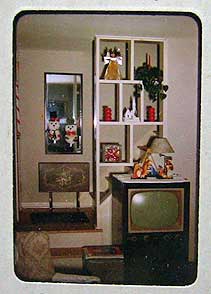The woman was obviously proud of her home. She had taken photos of it as it was being built in 1954:
The land laid bare to hold it, the wooden frame that would contain its rooms, the finished house in its brand-new blue color, and the tulips and daffodils that sprang up months after she planted them.
The photos were part of a large lot of family slides in boxes and special cases that I had purchased some time ago at auction and came across recently.

The house in Bloomfield, NJ, under construction in 1954.
I was spurred to take a closer look at them because a friend is having?work done at her home, and with it has come the?requisite anxiety and headaches. She?s having her walls repainted, the carpeting stripped and new dark wood floors installed.
Her experience, I?m certain, is way different from the person ? probably a woman ? who took the photos from 1954. That series of slides?infer?an excitement at watching this new space start from nothing in Bloomfield, NJ, and grow into a structure to be made into a home for the family. The slides were all dated with notes on the construction, along with inside and outside shots of the house over the next 10 or more years.
?Building 11 Craig Pl, Spring 1954,? was written succinctly on several slides.
?

The new house in September 1956.
Slides apparently were the choice of many folks during the mid-20th century because they appear on the auction tables pretty often. They show the stories of travels across the country and around the world, with notations on the white Kodachrome cards of place and year. It?s not uncommon to find hundreds of them ? long forgotten by the photo-takers?and now tossed by family who don?t know what to do with them.
The slides at auction were about more than just the building of one home for one family. They told the history of the making of the U.S. suburbs in the 1950s when many white families went looking outside large cities to start building a new life. Many of the men were World War II soldiers using the GI Bill to jump-start their dreams with a brand new home, a brand new wife and babies.
It was a time of prosperity in the country ? jobs, money and a willingness to spend ? against a backdrop of war and the Depression.

Flowering almond and tulips, May 1956.
The idea of?the suburbs didn?t start after World War II; its?had been around for more than a century. The first planned suburbs, though, didn?t arrive until?1947, when William J. Levitt built a segregated self-contained community in Levittown, NY, on Long Island.
Levitt?and his company developed similar plots with the same name in several states, including New Jersey and Pennsylvania (just northeast of Philadelphia, in 1952).
He also developed a system for building affordable cookie-cutter homes that were easily constructed assembly-line on-site. The Cape Cod-style homes were pretty basic: two bedrooms, one bath, a living room and kitchen, along with some appliances. They could be rented with an option to buy for $6,990. They were so popular that the houses were later boosted to $7,990 for sale only.

Christmas, 1956.
African Americans could not buy homes in the developments (Levitt included a clause forbidding it), but they were able to move in by secretly purchasing one from a?white family. William and Daisy Myers did just that in Levittown, PA, in 1957, secretly buying from a?Jewish family.? Although subject to mob harassment and protests, they?wouldn?t budge. After intervention by the governor?s office and the courts,?they apparently were left alone.
Most African Americans?didn?t bother to try to get into?these suburban enclaves, because segregated neighborhoods were a way of life. Even the federal government was no help. It?participated as much as private owners to keep them out. My grandfather was one of the lucky ones who was able to build a house for his family in a rural area of Georgia outside Macon. I cannot imagine what he had to go through to get it built.
The family in the slides obviously had an easier time of it. Someone in the family?decided to keep a record of their new home,?snapping photos of new additions (a side porch and garage)?that?upgraded it?and new tulips, daffodils and blooming trees that?beautified it.

Mother's airplane to Cleveland, Newark Airport, August 1956.
I?m sure that walking through the front door was an?exciting moment for them (although there were no slides of it).?Maybe it was their first house and she wanted to have the photos as memories. Or maybe she was trying out a new Kodak camera, which at that time were both popular, cheap and plentiful.
I Googled the address and found several real-estate pages with photos and information about the house.?It?s no longer the original color blue ? it?s now white on the web ? but it has ballooned in price. It is estimated at more than $250,000 and above.
Here are some other photos of the family?s home:

Picnic table and chairs in yard, 1958.
?

A car in the garage that was built in 1958. The photo was taken in 1960.
?

The house in May 1959.
Related posts:
- 1950s photos of cops, artist, black boys
- A witch ball for capturing evil spirits
- Family vacation slides
- Intimate photos
- ?A woman?s place is in the home? ? that was then
Source: http://myauctionfinds.com/2012/11/15/capturing-a-1950s-dream-home-in-photos/
blazing saddles lsu alabama lsu game lsu game beezow doo doo zopittybop bop bop cordova demaryius thomas
No comments:
Post a Comment